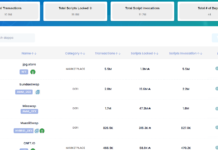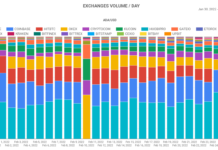What is Cardano
Cardano – a project that began in 2015 and grabbed a lot of attention not just because of its bold plans to create an internet of blockchains, but because of its start from around 2 pennies in late 2017 to nearly a dollar and 30 cents at the beginning of 2018. This parabolic price increase was, of course, not sustainable, and Ada’s price has since declined to around 3 pennies as of April 2020. If you’re a Cardano Ada holder, at which cost did you buy? And What is your Cardano price prediction? Let us know your answer in the comments. So, which is what is Cardano? And what is Ada? There isn’t one simple answer to the question of “What is Cardano?” First of all, Cardano and Ada are two different things. Cardano is a blockchain, while Ada is a cryptocurrency that lives on the Cardano blockchain. In other messages, Cardano is home to the Ada cryptocurrency. And while the Cardano blockchain can be used to send and receive ADA, it will also host smart contracts and applications.
How Cardano compares to Ethereum
Now, this may remind some of us of Ethereum since it does the same thing. And in fact, Cardano shares many of its roots with Ethereum. But although it is similar to Ethereum, Cardano’s smart contract platform operates much differently. Let’s jump right in. It’s not enough to simply say Ada lives on the cardio blockchain. Ada is a proof-of-stake coin that fuels Cardano. It´s determination is to provide a quick and secure transfer of value and to allow users to operate smart contracts and applications.
The maximum supply of Ada coins that will ever be created is capped at 45 billion. The current circulate supplying is 31 billion Ada coins. New coins enter the ecosystem and nodes validate events through a consensus algorithm called Ouroboros Proof-of-Stake. I’m going to throw out some technicals now, but stick with me, it’s not as complicated as it may sound. In this protocol, nodes who make a position as slot managers make brand-new blocks in the blockchain and authenticate the transactions.

Staking Ada
In this case, Cardano slot chairmen act operates much like Bitcoin miners do. Anyone maintaining ADA can be a stakeholder and become a slot leader. You become a slot leader and publish new blocks to the network when Cardano’s consensus algorithm selects a coin that you comprised. A node is selected to generate or mint a brand-new block with a likelihood proportional to the number of coins the node has. If a node has any amount of Ada ventured, it is called a “stakeholder”. If a node eventually becomes chosen to mint a new block, it is called a “slot supervisor”. What this simply implies is the more Cardano you braced, “the worlds largest” the possibilities of is to become a slot leader and receive payoffs. Now that we know a little something about Ada and the object and purpose, let’s dive a little further into the Cardano blockchain. Cardano is being developed in the two strata. This layered building is one of the key features that procreates Cardano unique.
First is the Cardano Settlement Layer which acts as the balance ledger and moves the transfer of ADA tokens. The other separate blanket is The Cardano Computation Layer which contains the information on why transactions arise. It’s this mantle that runs Cardano smart contracts. The two coatings separate the ledger of chronicle ethics from the reason why evaluates are moved from one account to the other. In other texts, Ada can be transferred from one account to another without the information from smart contracts moving along for the move. Why, because This dissociation enables greater flexibility for Cardano smart contracts. Since the computation layer is detached from the settlement layer, consumers of the computation layer is generated by rules to filter deals based on the parameters they specify. Such as a permissioned record that omits transactions that don’t include identification data- something that will become more important as blockchain regulation continues to increase.
Ada interoperability
Another key facet of Cardano will be the interoperability of blockchains. Think of this as the “internet of blockchains” – an ecosystem where Bitcoin can spurt into Ethereum and Ripple can seamlessly spurt into Litecoin. One practice that Cardano wants to do this is by implementing sidechains. Sidechains would enable cross-chain transportations without any middlemen. Cardano patronizes sidechains based on a new protocol called the KMZ sidechain. The KMZ sidechain protocol permits funds to move securely from the Computation Layer to any blockchain that likewise uses the same protocol. With this protocol, records with particular regulatory compliances are able to interact with the settlement layer without having to share the data that needs to remain private. There’s a lot more to go over, but our goal here was to provide a general overview of what reaches Cardano different from other blockchains and cryptocurrencies. If you’re a Cardano fan, let us know why in the comments section. And be sure to stumble the like and agree buttons for an optimistic year.






I don’t think the title of your article matches the content lol. Just kidding, mainly because I had some doubts after reading the article.
Your point of view caught my eye and was very interesting. Thanks. I have a question for you.
Can you be more specific about the content of your article? After reading it, I still have some doubts. Hope you can help me.
matadorbet porn
xnxx
Thanks for sharing. I read many of your blog posts, cool, your blog is very good.
Very informative and funny! For those curious to know more, check out: FIND OUT MORE. Let’s discuss!
Thanks for sharing. I read many of your blog posts, cool, your blog is very good.
I am curious to find out what blog system you’re using? I’m having some small security issues with my latest site and I would like to find something more risk-free. Do you have any recommendations?
hey there and thank you for your info – I have certainly picked up anything new from right here.
I did however expertise a few technical issues using this
website, as I experienced to reload the site many times previous to
I could get it to load properly. I had been wondering if your hosting is
OK? Not that I am complaining, but sluggish loading instances times will
sometimes affect your placement in google and can damage your high-quality score if ads and marketing with Adwords.
Anyway I am adding this RSS to my email and could look
out for much more of your respective intriguing content.
Ensure that you update this again very soon.. Escape room
I discovered your blog site on google and check a few of your early posts. Continue to keep up the very good operate. I just additional up your RSS feed to my MSN News Reader. Seeking forward to reading more from you later on!…
Everything is very open and very clear explanation of issues. was truly information. Your website is very useful. Thanks for sharing.
I do love the manner in which you have framed this specific situation and it really does offer me personally a lot of fodder for consideration. Nonetheless, from everything that I have experienced, I just simply hope when the reviews pile on that folks remain on point and don’t get started upon a soap box regarding the news of the day. Anyway, thank you for this outstanding piece and while I do not really agree with the idea in totality, I value the point of view.
I was looking at some of your articles on this
website and I believe this site is real instructive!
Continue posting.!
tipobet porn
귀하의 플랫폼은 정말로 저에게 게임 체인저였습니다. 귀하의 콘텐츠에서 얻은 통찰력은 매우 귀중했으며 귀하의 지도를 받아 계속해서 발견의 여정을 이어나가기를 기대합니다. 신뢰할 수 있는 지혜의 원천이 되어 주셔서 감사합니다!
I have recently started a website, the info you provide on this web site has helped me tremendously. Thanks for all of your time & work.
I haven¦t checked in here for a while as I thought it was getting boring, but the last several posts are good quality so I guess I will add you back to my daily bloglist. You deserve it my friend 🙂
purple pharmacy mexico price list
http://cmqpharma.com/# medicine in mexico pharmacies
mexico drug stores pharmacies
medication from mexico pharmacy: mexico pharmacy – medicine in mexico pharmacies
What Is LeanBiome? LeanBiome is a natural dietary supplement that promotes healthy weight loss.
Taxi Uber est un service de transport à la demande qui permet de réserver un trajet via une application mobile. Les prix et tarifs Uber https://taxiuber.fr/prixubertaxi sont calculés en fonction de la distance parcourue, du temps de trajet et de la demande en temps rée l. TaxiUber.Fr propose des tarifs transparents et des devis instantanés avant la réservation, assurant ainsi une meilleure planification des coûts pour les utilisateurs. De plus, diverses options de véhicules sont disponibles pour répondre aux besoins et budgets variés des clients.
Good post. I study one thing more difficult on totally different blogs everyday. It is going to always be stimulating to learn content material from other writers and follow a bit of something from their store. I’d favor to make use of some with the content material on my blog whether or not you don’t mind. Natually I’ll give you a hyperlink on your net blog. Thanks for sharing.
I real pleased to find this internet site on bing, just what I was looking for : D as well saved to fav.
buy medicines online in india [url=https://indiapharmast.com/#]indian pharmacy online[/url] best online pharmacy india
purple pharmacy mexico price list: medication from mexico pharmacy – mexican rx online
http://indiapharmast.com/# india pharmacy mail order
mexico drug stores pharmacies: reputable mexican pharmacies online – mexican pharmacy
reputable indian online pharmacy [url=http://indiapharmast.com/#]top 10 pharmacies in india[/url] reputable indian online pharmacy
medication canadian pharmacy: pharmacy canadian – onlinecanadianpharmacy 24
mexican rx online: buying prescription drugs in mexico online – mexican online pharmacies prescription drugs
best india pharmacy: world pharmacy india – Online medicine home delivery
canada pharmacy world [url=https://canadapharmast.online/#]canadian neighbor pharmacy[/url] online pharmacy canada
http://foruspharma.com/# mexican rx online
buying prescription drugs in mexico: buying prescription drugs in mexico – buying prescription drugs in mexico
the canadian drugstore: canada drugs online – canadadrugpharmacy com
india pharmacy mail order: world pharmacy india – top 10 online pharmacy in india
canadian drugs online [url=http://canadapharmast.com/#]canadianpharmacyworld[/url] prescription drugs canada buy online
http://indiapharmast.com/# india pharmacy mail order
buying prescription drugs in mexico online: buying from online mexican pharmacy – buying prescription drugs in mexico
Can you be more specific about the content of your article? After reading it, I still have some doubts. Hope you can help me.
prescription drugs canada buy online: certified canadian pharmacy – online canadian pharmacy
I must thank you for the efforts you have put in penning this website. I am hoping to check out the same high-grade blog posts by you later on as well. In fact, your creative writing abilities has inspired me to get my own blog now 😉
canadian pharmacies compare: canadian pharmacy in canada – buy canadian drugs
https://amoxildelivery.pro/# medicine amoxicillin 500
amoxicillin discount coupon [url=http://amoxildelivery.pro/#]buy amoxicillin 500mg uk[/url] buy cheap amoxicillin
https://clomiddelivery.pro/# buy clomid without rx
https://paxloviddelivery.pro/# paxlovid pharmacy
paxlovid pharmacy [url=http://paxloviddelivery.pro/#]paxlovid pharmacy[/url] paxlovid covid
Great information. Lucky me I discovered your website by chance (stumbleupon). I’ve saved it for later!
very nice publish, i actually love this web site, carry on it
https://ciprodelivery.pro/# ciprofloxacin 500mg buy online
http://paxloviddelivery.pro/# paxlovid pill
buy generic ciprofloxacin [url=http://ciprodelivery.pro/#]ciprofloxacin over the counter[/url] cipro 500mg best prices
Good info. Lucky me I came across your site by chance (stumbleupon). I’ve saved it for later.
Paxlovid over the counter: Paxlovid buy online – paxlovid generic
https://clomiddelivery.pro/# can you buy cheap clomid for sale
naturally like your web site however you have to test the spelling on quite a few of your posts. A number of them are rife with spelling issues and I in finding it very bothersome to tell the reality nevertheless I?¦ll surely come back again.
https://doxycyclinedelivery.pro/# doxycycline with out a rx
generic amoxicillin cost [url=https://amoxildelivery.pro/#]amoxicillin medicine over the counter[/url] amoxacillian without a percription
where can i get doxycycline pills: how can i get doxycycline over the counter – doxycycline 100mg tablet
https://clomiddelivery.pro/# cost of generic clomid tablets
Thanks for sharing. I read many of your blog posts, cool, your blog is very good.
https://ciprodelivery.pro/# cipro ciprofloxacin
where to get clomid prices [url=http://clomiddelivery.pro/#]clomid buy[/url] can i buy clomid for sale
http://ciprodelivery.pro/# buy generic ciprofloxacin
buy cipro online usa: cipro – ciprofloxacin 500 mg tablet price
http://ciprodelivery.pro/# where can i buy cipro online
http://paxloviddelivery.pro/# paxlovid pill
how to get clomid price [url=https://clomiddelivery.pro/#]can you get clomid without dr prescription[/url] where can i get cheap clomid without dr prescription
https://amoxildelivery.pro/# generic amoxicillin 500mg
paxlovid price: paxlovid covid – paxlovid covid
https://paxloviddelivery.pro/# buy paxlovid online
doxycycline 75 mg price [url=https://doxycyclinedelivery.pro/#]doxycycline acne[/url] doxycycline vibramycin
You’re so interesting! I do not believe I’ve truly read a single thing like that before. So great to find somebody with some original thoughts on this issue. Really.. thank you for starting this up. This site is something that is needed on the web, someone with a little originality.
http://clomiddelivery.pro/# cost of generic clomid pill
http://doxycyclinedelivery.pro/# generic doxycycline 200 mg
paxlovid india [url=https://paxloviddelivery.pro/#]paxlovid cost without insurance[/url] buy paxlovid online
clomid brand name: how to buy clomid without dr prescription – where buy generic clomid pill
Your article helped me a lot, is there any more related content? Thanks!
amoxicillin pharmacy price: where to buy amoxicillin pharmacy – buy amoxicillin 500mg canada
I don’t think the title of your article matches the content lol. Just kidding, mainly because I had some doubts after reading the article.
I’m very happy to read this. This is the kind of manual that needs to be given and not the random misinformation that’s at the other blogs. Appreciate your sharing this greatest doc.
doxycycline 100mg online pharmacy: where to buy doxycycline in australia – generic for doxycycline
Oh my goodness! Impressive article dude! Thank you, However I am encountering problems with your RSS. I don’t understand why I cannot join it. Is there anybody having similar RSS problems? Anyone that knows the answer will you kindly respond? Thanks!
buying prescription drugs in mexico online [url=https://mexicandeliverypharma.online/#]medicine in mexico pharmacies[/url] п»їbest mexican online pharmacies
https://mexicandeliverypharma.online/# mexican mail order pharmacies
mexican online pharmacies prescription drugs: mexican drugstore online – mexican online pharmacies prescription drugs
medicine in mexico pharmacies: mexican rx online – buying prescription drugs in mexico online
mexican pharmacy [url=https://mexicandeliverypharma.online/#]mexican border pharmacies shipping to usa[/url] pharmacies in mexico that ship to usa
purple pharmacy mexico price list: medicine in mexico pharmacies – purple pharmacy mexico price list
buying prescription drugs in mexico online: mexican rx online – mexican rx online
http://mexicandeliverypharma.com/# reputable mexican pharmacies online
pharmacies in mexico that ship to usa [url=https://mexicandeliverypharma.online/#]mexican mail order pharmacies[/url] mexico drug stores pharmacies
mexican border pharmacies shipping to usa: mexican border pharmacies shipping to usa – п»їbest mexican online pharmacies
mexican online pharmacies prescription drugs: mexican mail order pharmacies – mexican mail order pharmacies
https://mexicandeliverypharma.online/# mexican mail order pharmacies
mexican rx online [url=https://mexicandeliverypharma.com/#]mexican pharmaceuticals online[/url] mexico drug stores pharmacies
mexican rx online: mexico pharmacies prescription drugs – mexican pharmaceuticals online
mexico drug stores pharmacies: pharmacies in mexico that ship to usa – mexico drug stores pharmacies
reputable mexican pharmacies online [url=https://mexicandeliverypharma.online/#]buying prescription drugs in mexico online[/url] purple pharmacy mexico price list
п»їbest mexican online pharmacies: medicine in mexico pharmacies – mexican border pharmacies shipping to usa
purple pharmacy mexico price list: mexican drugstore online – medicine in mexico pharmacies
medicine in mexico pharmacies: п»їbest mexican online pharmacies – mexican pharmaceuticals online
https://mexicandeliverypharma.online/# buying prescription drugs in mexico
medicine in mexico pharmacies [url=https://mexicandeliverypharma.online/#]mexico drug stores pharmacies[/url] mexican pharmaceuticals online
reputable mexican pharmacies online: medicine in mexico pharmacies – mexican border pharmacies shipping to usa
reputable mexican pharmacies online: п»їbest mexican online pharmacies – mexican mail order pharmacies
п»їbest mexican online pharmacies: buying prescription drugs in mexico – mexican mail order pharmacies
mexican border pharmacies shipping to usa [url=http://mexicandeliverypharma.com/#]mexico pharmacy[/url] mexico pharmacies prescription drugs
I’d like to thank you for the efforts you have put in penning this site. I really hope to view the same high-grade content from you in the future as well. In truth, your creative writing abilities has encouraged me to get my own website now 😉
pharmacies in mexico that ship to usa: best online pharmacies in mexico – pharmacies in mexico that ship to usa
mexican mail order pharmacies: mexican pharmaceuticals online – mexican mail order pharmacies
best online pharmacies in mexico: mexico drug stores pharmacies – mexican rx online
mexico pharmacy [url=https://mexicandeliverypharma.online/#]medicine in mexico pharmacies[/url] mexican mail order pharmacies
buying prescription drugs in mexico online: mexican pharmaceuticals online – reputable mexican pharmacies online
buying prescription drugs in mexico online: mexico drug stores pharmacies – mexican pharmaceuticals online
mexican rx online: reputable mexican pharmacies online – mexico pharmacies prescription drugs
buying prescription drugs in mexico [url=https://mexicandeliverypharma.com/#]buying prescription drugs in mexico online[/url] buying from online mexican pharmacy
buying prescription drugs in mexico online: medication from mexico pharmacy – reputable mexican pharmacies online
buying from online mexican pharmacy: mexican drugstore online – mexican drugstore online
mexican pharmaceuticals online: buying prescription drugs in mexico – buying prescription drugs in mexico online
buying from online mexican pharmacy [url=https://mexicandeliverypharma.com/#]mexico pharmacy[/url] buying from online mexican pharmacy
mexico drug stores pharmacies: best online pharmacies in mexico – п»їbest mexican online pharmacies
mexican mail order pharmacies: medication from mexico pharmacy – medication from mexico pharmacy
mexican pharmaceuticals online: mexican mail order pharmacies – buying prescription drugs in mexico online
I don’t think the title of your article matches the content lol. Just kidding, mainly because I had some doubts after reading the article.
mexican pharmacy [url=http://mexicandeliverypharma.com/#]mexican drugstore online[/url] pharmacies in mexico that ship to usa
mexican drugstore online: mexico drug stores pharmacies – mexican drugstore online
medication from mexico pharmacy: mexican online pharmacies prescription drugs – pharmacies in mexico that ship to usa
buying prescription drugs in mexico online: mexican mail order pharmacies – mexican mail order pharmacies
pharmacies in mexico that ship to usa [url=https://mexicandeliverypharma.com/#]mexican pharmaceuticals online[/url] mexico drug stores pharmacies
mexican rx online: pharmacies in mexico that ship to usa – best online pharmacies in mexico
mexico drug stores pharmacies: buying prescription drugs in mexico – best online pharmacies in mexico
mexican mail order pharmacies: mexican mail order pharmacies – medication from mexico pharmacy
best online pharmacies in mexico [url=https://mexicandeliverypharma.com/#]mexico drug stores pharmacies[/url] mexican online pharmacies prescription drugs
mexican border pharmacies shipping to usa: medicine in mexico pharmacies – mexican mail order pharmacies
buying from online mexican pharmacy: mexico drug stores pharmacies – mexican online pharmacies prescription drugs
best online pharmacies in mexico: mexican online pharmacies prescription drugs – п»їbest mexican online pharmacies
mexico pharmacy [url=http://mexicandeliverypharma.com/#]mexican drugstore online[/url] mexico pharmacy
medicine in mexico pharmacies: mexico pharmacies prescription drugs – pharmacies in mexico that ship to usa
mexico drug stores pharmacies: buying prescription drugs in mexico – medicine in mexico pharmacies
mexican mail order pharmacies: mexico drug stores pharmacies – buying prescription drugs in mexico
buying prescription drugs in mexico [url=http://mexicandeliverypharma.com/#]medication from mexico pharmacy[/url] mexican pharmacy
mexican mail order pharmacies: mexico drug stores pharmacies – medicine in mexico pharmacies
medicine in mexico pharmacies: mexican online pharmacies prescription drugs – buying prescription drugs in mexico online
purple pharmacy mexico price list: reputable mexican pharmacies online – purple pharmacy mexico price list
buying prescription drugs in mexico online [url=https://mexicandeliverypharma.com/#]best online pharmacies in mexico[/url] buying prescription drugs in mexico online
purple pharmacy mexico price list: medication from mexico pharmacy – pharmacies in mexico that ship to usa
purple pharmacy mexico price list: mexico drug stores pharmacies – buying from online mexican pharmacy
Oh my goodness! Incredible article dude! Thanks, However I am experiencing troubles with your RSS. I don’t know why I cannot join it. Is there anyone else getting the same RSS issues? Anybody who knows the answer can you kindly respond? Thanks.
п»їbest mexican online pharmacies: mexico drug stores pharmacies – purple pharmacy mexico price list
Fantastic post however I was wondering if you could write a litte more on this topic? I’d be very thankful if you could elaborate a little bit further. Thanks!
Comments are closed.